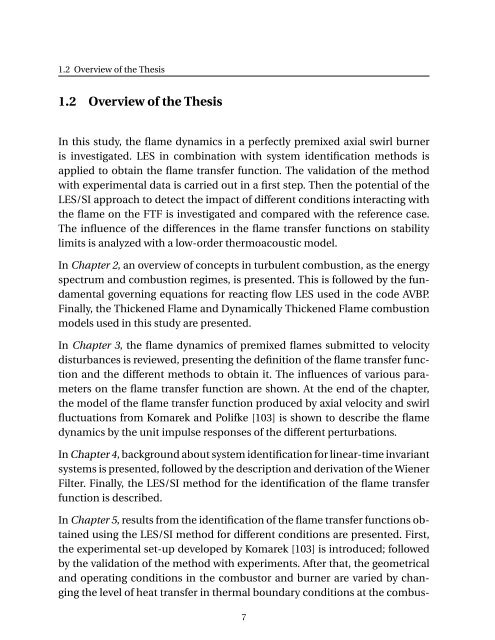Numerical Simulation of the Dynamics of Turbulent Swirling Flames
Numerical Simulation of the Dynamics of Turbulent Swirling Flames
Numerical Simulation of the Dynamics of Turbulent Swirling Flames
You also want an ePaper? Increase the reach of your titles
YUMPU automatically turns print PDFs into web optimized ePapers that Google loves.
1.2 Overview <strong>of</strong> <strong>the</strong> Thesis<br />
1.2 Overview <strong>of</strong> <strong>the</strong> Thesis<br />
In this study, <strong>the</strong> flame dynamics in a perfectly premixed axial swirl burner<br />
is investigated. LES in combination with system identification methods is<br />
applied to obtain <strong>the</strong> flame transfer function. The validation <strong>of</strong> <strong>the</strong> method<br />
with experimental data is carried out in a first step. Then <strong>the</strong> potential <strong>of</strong> <strong>the</strong><br />
LES/SI approach to detect <strong>the</strong> impact <strong>of</strong> different conditions interacting with<br />
<strong>the</strong> flame on <strong>the</strong> FTF is investigated and compared with <strong>the</strong> reference case.<br />
The influence <strong>of</strong> <strong>the</strong> differences in <strong>the</strong> flame transfer functions on stability<br />
limits is analyzed with a low-order <strong>the</strong>rmoacoustic model.<br />
In Chapter 2, an overview <strong>of</strong> concepts in turbulent combustion, as <strong>the</strong> energy<br />
spectrum and combustion regimes, is presented. This is followed by <strong>the</strong> fundamental<br />
governing equations for reacting flow LES used in <strong>the</strong> code AVBP.<br />
Finally, <strong>the</strong> Thickened Flame and Dynamically Thickened Flame combustion<br />
models used in this study are presented.<br />
In Chapter 3, <strong>the</strong> flame dynamics <strong>of</strong> premixed flames submitted to velocity<br />
disturbances is reviewed, presenting <strong>the</strong> definition <strong>of</strong> <strong>the</strong> flame transfer function<br />
and <strong>the</strong> different methods to obtain it. The influences <strong>of</strong> various parameters<br />
on <strong>the</strong> flame transfer function are shown. At <strong>the</strong> end <strong>of</strong> <strong>the</strong> chapter,<br />
<strong>the</strong> model <strong>of</strong> <strong>the</strong> flame transfer function produced by axial velocity and swirl<br />
fluctuations from Komarek and Polifke [103] is shown to describe <strong>the</strong> flame<br />
dynamics by <strong>the</strong> unit impulse responses <strong>of</strong> <strong>the</strong> different perturbations.<br />
In Chapter 4, background about system identification for linear-time invariant<br />
systems is presented, followed by <strong>the</strong> description and derivation <strong>of</strong> <strong>the</strong> Wiener<br />
Filter. Finally, <strong>the</strong> LES/SI method for <strong>the</strong> identification <strong>of</strong> <strong>the</strong> flame transfer<br />
function is described.<br />
In Chapter 5, results from <strong>the</strong> identification <strong>of</strong> <strong>the</strong> flame transfer functions obtained<br />
using <strong>the</strong> LES/SI method for different conditions are presented. First,<br />
<strong>the</strong> experimental set-up developed by Komarek [103] is introduced; followed<br />
by <strong>the</strong> validation <strong>of</strong> <strong>the</strong> method with experiments. After that, <strong>the</strong> geometrical<br />
and operating conditions in <strong>the</strong> combustor and burner are varied by changing<br />
<strong>the</strong> level <strong>of</strong> heat transfer in <strong>the</strong>rmal boundary conditions at <strong>the</strong> combus-<br />
7
















